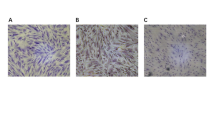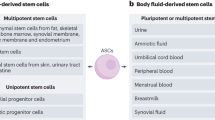Abstract
The main goal of the study was to identify a novel source of human multipotent cells, overcoming ethical issues involved in embryonic stem cell research and the limited availability of most adult stem cells. Amniotic fluid cells (AFCs) are routinely obtained for prenatal diagnosis and can be expanded in vitro; nevertheless current knowledge about their origin and properties is limited. Twenty samples of AFCs were exposed in culture to adipogenic, osteogenic, neurogenic and myogenic media. Differentiation was evaluated using immunocytochemistry, RT-PCR and Western blotting. Before treatments, AFCs showed heterogeneous morphologies. They were negative for MyoD, Myf-5, MRF4, Myogenin and Desmin but positive for osteocalcin, PPARgamma2, GAP43, NSE, Nestin, MAP2, GFAP and beta tubulin III by RT-PCR. The cells expressed Oct-4, Rex-1 and Runx-1, which characterize the undifferentiated stem cell state. By immunocytochemistry they expressed neural-glial proteins, mesenchymal and epithelial markers. After culture, AFCs differentiated into adipocytes and osteoblasts when the predominant cellular component was fibroblastic. Early and late neuronal antigens were still present after 2 week culture in neural specific media even if no neuronal morphologies were detectable. Our results provide evidence that human amniotic fluid contains progenitor cells with multi-lineage potential showing stem and tissue-specific gene/protein presence for several lineages.
Similar content being viewed by others
Log in or create a free account to read this content
Gain free access to this article, as well as selected content from this journal and more on nature.com
or
References
Holden C, Vogel G . Stem cells. Plasticity: time for a reappraisal? Science 2002; 296:2126–2129.
Rice CM, Scolding NJ . Adult stem cells—reprogramming neurological repair? Lancet 2004; 364:193–199.
Fauza D . Amniotic fluid and placental stem cells. Best Pract Res Clin Obstet Gynaecol 2004; 18:877–891.
Hoehn H, Salk D . Morphological and biochemical heterogeneity of amniotic fluid cells in culture. Methods Cell Biol 1982; 26:11–34.
Gosden CM . Amniotic fluid cell types and culture. Br Med Bull 1983; 39:348–354.
Prusa AR, Hengstschlager M . Amniotic fluid cells and human stem cell research: a new connection. Med Sci Monit 2002; 8:RA253–257.
Sakuragawa N, Thangavel R, Mizuguchi M, Hirasawa M, Kamo I . Expression of markers for both neuronal and glial cells in human amniotic epithelial cells. Neurosci Lett 1996; 209:9–12.
Ishii T, Ohsugi K, Nakamura S, et al. Gene expression of oligodendrocyte markers in human amniotic epithelial cells using neural cell-type-specific expression system. Neurosci Lett 1999; 268:131–134.
Okawa H, Okuda O, Arai H, Sakuragawa N, Sato K . Amniotic epithelial cells transform into neuron-like cells in the ischemic brain. Neuroreport 2001; 12:4003–4007.
In ′t Anker PS, Scherjon SA, Kleijburg-van der Keur C, et al. Amniotic fluid as a novel source of mesenchymal stem cells for therapeutic transplantation. Blood 2003; 102:1548–1549.
Kaviani A, Guleserian K, Perry TE, et al. Fetal tissue engineering from amniotic fluid. J Am Coll Surg 2003; 196:592–597.
In ′t Anker PS, Scherjon SA, Kleijburg-van der Keur C, et al. Isolation of mesenchymal stem cells of fetal or maternal origin from human placenta. Stem Cells 2004; 22:1338–1345.
Tsai MS, Lee JL, Chang YJ, Hwang SM . Isolation of human multipotent mesenchymal stem cells from second-trimester amniotic fluid using a novel two-stage culture protocol. Hum Reprod 2004; 19:1450–1456.
Gritti A, Frolichsthal-Schoeller P, Galli R, et al. Epidermal and fibroblast growth factors behave as mitogenic regulators for a single multipotent stem cell-like population from the subventricular region of the adult mouse forebrain. J Neurosci 1999; 19:3287–3297.
Bergeron MJ, Leclerc S, Laniel MA, Poirier GG, Guerin SL . Transcriptional regulation of the rat poly(ADP-ribose) polymerase gene by Sp1. Eur J Biochem 1997; 250:342–353.
Riol H, Tardy M, Rolland B, Levesque G, Murthy MR . Detection of the peripheral nervous system (PNS)-type glial fibrillary acidic protein (GFAP) and its mRNA in human lymphocytes. J Neurosci Res 1997; 48:53–62.
Sakuragawa N, Misawa H, Ohsugi K, et al. Evidence for active acetylcholine metabolism in human amniotic epithelial cells: applicable to intracerebral allografting for neurologic disease. Neurosci Lett 1997; 232:53–56.
Kakishita K, Elwan MA, Nakao N, Itakura T, Sakuragawa N . Human amniotic epithelial cells produce dopamine and survive after implantation into the striatum of a rat model of Parkinson's disease: a potential source of donor for transplantation therapy. Exp Neurol 2000; 165:27–34.
Sankar V, Muthusamy R . Role of human amniotic epithelial cell transplantation in spinal cord injury repair research. Neuroscience 2003; 118:11–17.
Prusa AR, Marton E, Rosner M, et al. Neurogenic cells in human amniotic fluid. Am J Obstet Gynecol 2004; 191:309–314.
Lu P, Blesch A, Tuszynski MH . Induction of bone marrow stromal cells to neurons: differentiation, transdifferentiation, or artifact? J Neurosci Res 2004; 77:174–191.
Neuhuber B, Gallo G, Howard L, et al. Reevaluation of in vitro differentiation protocols for bone marrow stromal cells: disruption of actin cytoskeleton induces rapid morphological changes and mimics neuronal phenotype. J Neurosci Res 2004; 77:192–204.
Hunziker E, Stein M . Nestin-expressing cells in the pancreatic islets of Langerhans. Biochem Biophys Res Commun 2000; 271:116–119.
Street CN, Lakey JR, Seeberger K, et al. Heterogenous expression of nestin in human pancreatic tissue precludes its use as an islet precursor marker. J Endocrinol 2004; 180:213–225.
Chen Z, de Paiva CS, Luo L, et al. Characterization of putative stem cell phenotype in human limbal epithelia. Stem Cells 2004; 22:355–366.
Kojima K, Takebayashi S, Nakagawa T, Iwai K, Ito J . Nestin expression in the developing rat cochlea sensory epithelia. Acta Otolaryngol Suppl 2004: 14–17.
Wiese C, Rolletschek A, Kania G, et al. Nestin expression—a property of multi-lineage progenitor cells? Cell Mol Life Sci 2004; 61:2510–2522.
Eng LF, Ghirnikar RS, Lee YL . Glial fibrillary acidic protein: GFAP-thirty-one years (1969–2000). Neurochem Res 2000; 25:1439–1451.
Bush TG, Savidge TC, Freeman TC, et al. Fulminant jejuno-ileitis following ablation of enteric glia in adult transgenic mice. Cell 1998; 93:189–201.
Ghazanfari FA, Stewart RR . Characteristics of endothelial cells derived from the blood-brain barrier and of astrocytes in culture. Brain Res 2001; 890:49–65.
Tsangaris G, Weitzdorfer R, Pollak D, Lubec G, Fountoulakis M . The amniotic fluid cell proteome. Electrophoresis 2005; 26:1168–1173.
Acknowledgements
This work was supported by grants from Cariplo, Ministero della Salute (Progetto Ricerca Finalizzata 2002 e 2003, Malattie Neurodegenerative, ex art. 56 Anno 2003), Ministero dell'Istruzione, dell'Università e della Ricerca (FIRB 2001), Programma Nazionale Cellule Staminali 2003 - Istituto Superiore di Sanità and Fondazione I.Monzino. The authors thank Dr J Hemingway and Prof B Péault for critically reading the manuscript and Dr D Giardino for providing part of the amniotic fluid samples used in this study and for her helpful technical support.
Author information
Authors and Affiliations
Corresponding author
Rights and permissions
About this article
Cite this article
Bossolasco, P., Montemurro, T., Cova, L. et al. Molecular and phenotypic characterization of human amniotic fluid cells and their differentiation potential. Cell Res 16, 329–336 (2006). https://doi.org/10.1038/sj.cr.7310043
Received:
Revised:
Accepted:
Published:
Issue date:
DOI: https://doi.org/10.1038/sj.cr.7310043
Keywords
This article is cited by
-
Amniotic fluid mesenchymal stem cells repair mouse corneal cold injury by promoting mRNA N4-acetylcytidine modification and ETV4/JUN/CCND2 signal axis activation
Human Cell (2021)
-
Therapeutic mesenchymal stromal stem cells: Isolation, characterization and role in equine regenerative medicine and metabolic disorders
Stem Cell Reviews and Reports (2020)
-
Identification and characterization of two morphologically distinct stem cell subpopulations from human urine samples
Science China Life Sciences (2020)
-
Developmental Programming of Body Composition: Update on Evidence and Mechanisms
Current Diabetes Reports (2019)
-
Low-affinity Nerve Growth Factor Receptor (CD271) Heterogeneous Expression in Adult and Fetal Mesenchymal Stromal Cells
Scientific Reports (2018)



